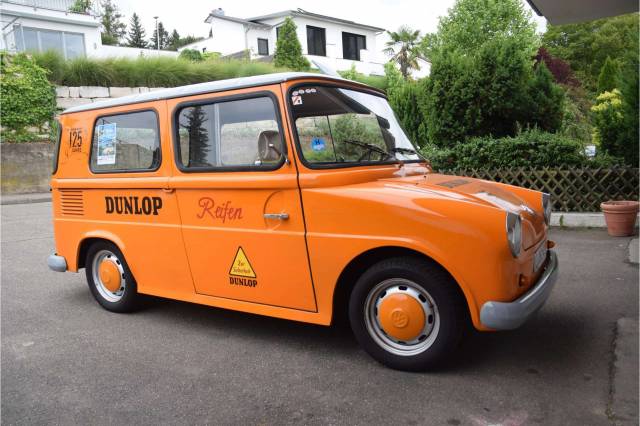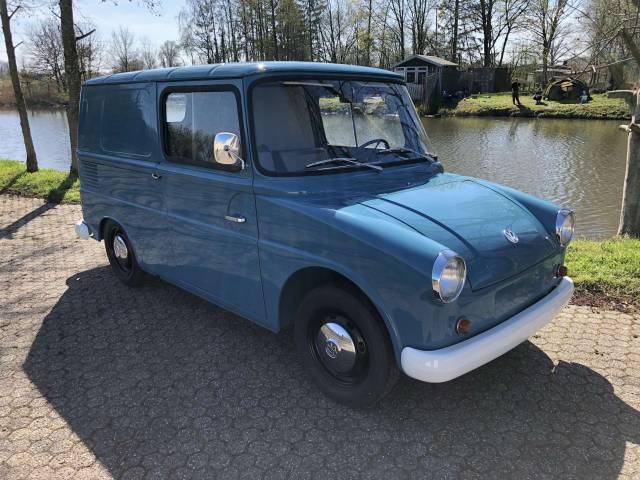- Voiture
- Volkswagen
- Volkswagen Fridolin (0 one offre)
Volkswagen Fridolin classic cars for sale
The Volkswagen Fridolin, officially known as Type 147, stands out as one of the most distinctive and rare utility vehicles ever built by Volkswagen. Initially developed for the needs of the Deutsche Bundespost, it combines mechanical components from various VW models within a purpose-built van body. Extremely limited production numbers and unique construction details make any Fridolin a rare find today.
Résultats de la recherche
À l'heure actuelle, il n'y a pas d'annonces correspondant à votre recherche.
Create search alert
Let yourself be notified as soon as a listing is published that matches your search filters.
Create listing
Do you have a Volkswagen Fridolin that you want to sell? Then create a listing now.
Create listingVolkswagen Fridolin listing references from Classic Trader
Below you will find listings related to your search that are no longer available on Classic Trader. Use this information to gain insight into availability, value trends, and current pricing for a "Volkswagen Fridolin" to make a more informed purchasing decision.

1973 | Volkswagen Fridolin

1970 | Volkswagen Fridolin
Create search alert
Let yourself be notified as soon as a listing is published that matches your search filters.
Create listing
Do you have a Volkswagen Fridolin that you want to sell? Then create a listing now.
Create listingHistory of the Volkswagen Fridolin
The Volkswagen Fridolin (Type 147) was produced between 1964 and 1974 by Volkswagen Commercial Vehicles, specifically designed on commission for the Deutsche Bundespost, the German postal service. Its creation arose from the need for a reliable, compact delivery vehicle with easy access and practicality for frequent stops—demands that were not fulfilled by VW’s existing models at the time. The engineering approach was pragmatic: the Fridolin combines the floorpan of the VW Type 1 (Beetle), the front axle of the Karmann Ghia, the engine from the Beetle, and various other parts from the Type 3 and Transporter ranges. All bodies were supplied by Westfalia, and production figures remained exceptionally low, with only about 6,139 vehicles manufactured. After their service in postal fleets, most were discarded or extensively worn, making survivors noteworthy.
Model History
The Fridolin has no real predecessor; it filled a unique role for the Deutsche Bundespost that previously relied on a diverse selection of vehicles. The Type 147 replaced a mix of light vans and cars but had no direct VW antecedent. The model was not replaced within Volkswagen’s lineup after its discontinuation in 1974. All Fridolins were similar in structure, with only minor specification differences depending on their end user (German or Swiss Post, Lufthansa, etc.).
Highlights of the Volkswagen Fridolin
The Fridolin’s standout features include its highly specialized postal van body, complete with sliding doors for rapid ingress and egress, flat loading floors, and a focus on practicality. Unlike any other VW van of its era, it is a patchwork of proven Volkswagen mechanicals under a unique Westfalia-built shell. Due to the low production volume and highly specific use case, original Fridolins are rarely seen outside enthusiast circles. Its quirky design, utilitarian roots, and extreme rarity attract collectors and VW specialists alike.
Technical Data
Special Editions and Collectible Models
There were no official special editions of the Fridolin. Minor variations exist primarily due to end-user requirements (such as German versus Swiss Post specifications), but all were fundamentally the same in body and structure. Lufthansa and some municipal fleets also used modified versions, occasionally featuring altered livery or fittings specific to their function.
Weak Spots and Common Issues
The Fridolin is more susceptible to severe rust than comparable Volkswagen models, especially around sills, window frames (notably the windscreen), front and rear valances, door bottoms, and the cargo floor. The sliding doors exacerbate moisture intrusion, accelerating rust. No new body panels are available; restoration inevitably involves custom metalwork, making a sound body the top priority in any purchase or restoration. The rear swing axle, while sturdy, imparts unique driving behaviour (tendency to oversteer when pushed) and requires familiarization. Interiors are often missing or heavily worn, and original elements (seating, trim, mats) are exceedingly difficult to find. While mechanical parts from the Beetle and T2 can be sourced, anything specific to the Fridolin’s shell or trim presents a challenge. The cost of a full restoration often surpasses the post-restoration market value due to these bodywork issues.
Engine, Performance, Transmission and Handling
Fitted with the tried-and-tested VW Beetle 1.2L flat-four engine and a manual transmission, the Fridolin delivers moderate performance suitable for stop-start urban use rather than high speed. Its swing axle rear suspension can feel lively, especially with shifting cargo loads, and takes practice to master. The driving position and pedal arrangement are unconventional but serviceable after acclimatisation. All Fridolins are fundamentally similar, with no sub-model distinctions. Key technical interest lies in sourcing examples retaining original postal equipment or special features installed for their unique user requirements.
Interior, Comfort, Exterior and Design
The Fridolin’s design centres on utility, with a high-roof, slab-sided van body, prominent sliding doors, and an unobstructed loading floor. All bodies were manufactured by Westfalia and featured simple, hardwearing interior materials. Most surviving vehicles have lost their original trim due to hard use; original seating, lining, and mats are rare. Special accessories were minimal; the Swiss and Lufthansa variants occasionally had bespoke equipment or livery. Colour schemes reflected postal service standards, and there was little focus on comfort or luxury. Instrumentation is spartan but serviceable for its intended use.
Other Noteworthy Features
The extreme scarcity of body parts and original trim makes the Fridolin a van primarily for specialist restorers and enthusiastic clubs, which do exist to pool knowledge and rare components. Most surviving vehicles are actively exchanged within a small, dedicated community that supports restoration and originality on a global scale.
Summary
The Volkswagen Fridolin represents a true outlier in classic Volkswagen history—purpose-built for state utility, manufactured in tiny numbers, and featuring a unique marriage of mechanical parts under a body created exclusively for workhorse duty. Its survival today is down to the perseverance of a niche community, and prospective buyers should prioritise body condition due to the impossibility of sourcing new panels. Rarity and technical interest come not from luxury or speed, but from the very nature of its service-led past and the high hurdles of preservation.